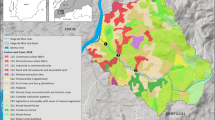Abstract.
Anadromous Pacific salmon (Oncorhynchus spp.) transport marine-derived nitrogen (MDN) to the rivers in which they spawn. Isotopic analyses of riparian vegetation in a boreal Alaskan watershed indicate that trees and shrubs near spawning streams derive ~24–26% of their foliar nitrogen (N) from salmon. Basal area growth of white spruce (Picea glauca) is enhanced at sites receiving MDN inputs. This marine N subsidy appears to be less important to riparian ecosystems where symbiotic N fixation by alder (Alnus crispa) is prevalent, although salmon carcasses may nonetheless be an important source of other marine-derived nutrients affecting productivity in these forests. These findings illustrate the complexity of interactions surrounding riparian forests and the interconnectedness of river and riparian ecosystems.
Similar content being viewed by others
Author information
Authors and Affiliations
Corresponding author
Additional information
Electronic Publication
Rights and permissions
About this article
Cite this article
Helfield, J.M., Naiman, R.J. Salmon and alder as nitrogen sources to riparian forests in a boreal Alaskan watershed. Oecologia 133, 573–582 (2002). https://doi.org/10.1007/s00442-002-1070-x
Received:
Accepted:
Published:
Issue Date:
DOI: https://doi.org/10.1007/s00442-002-1070-x




